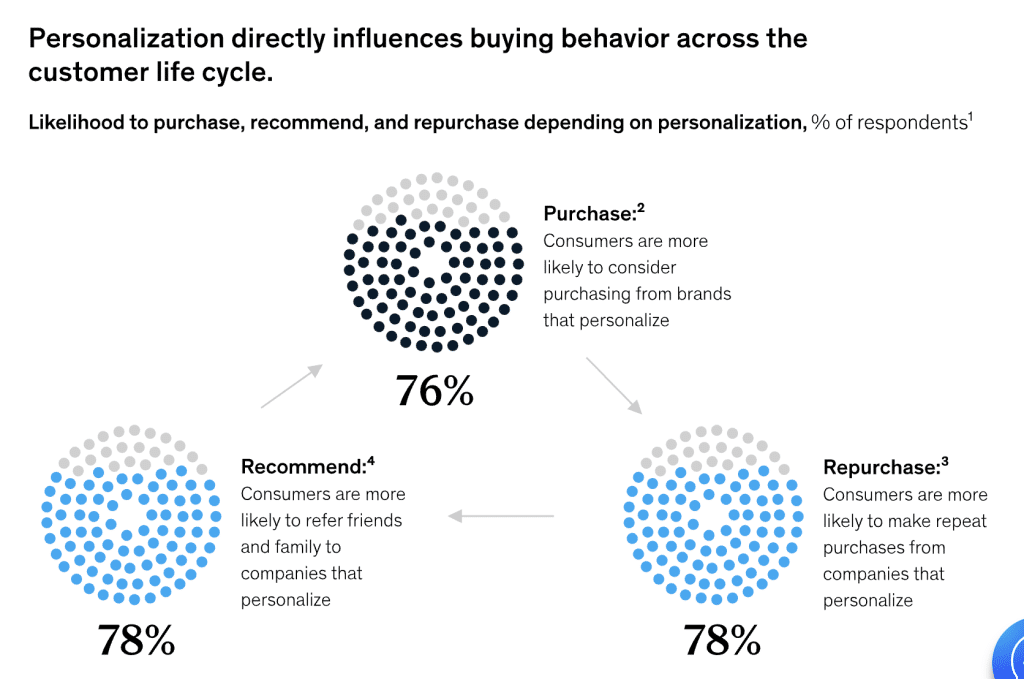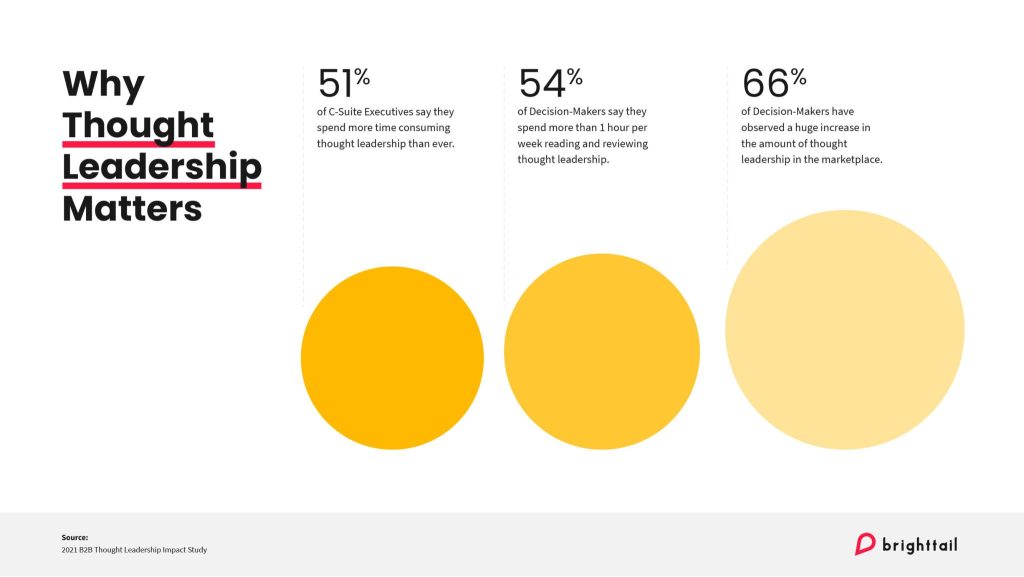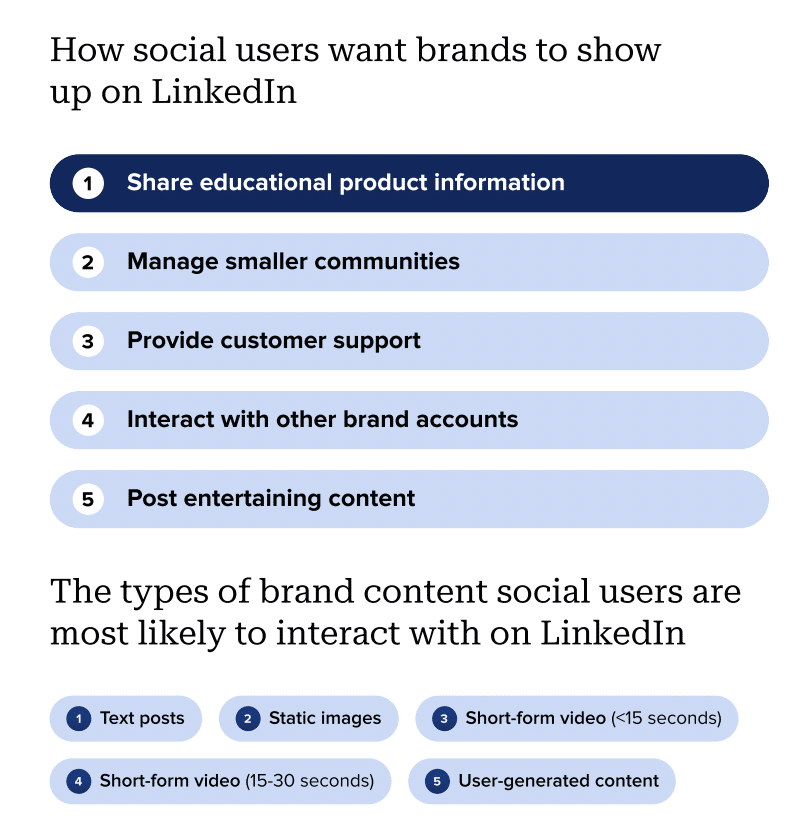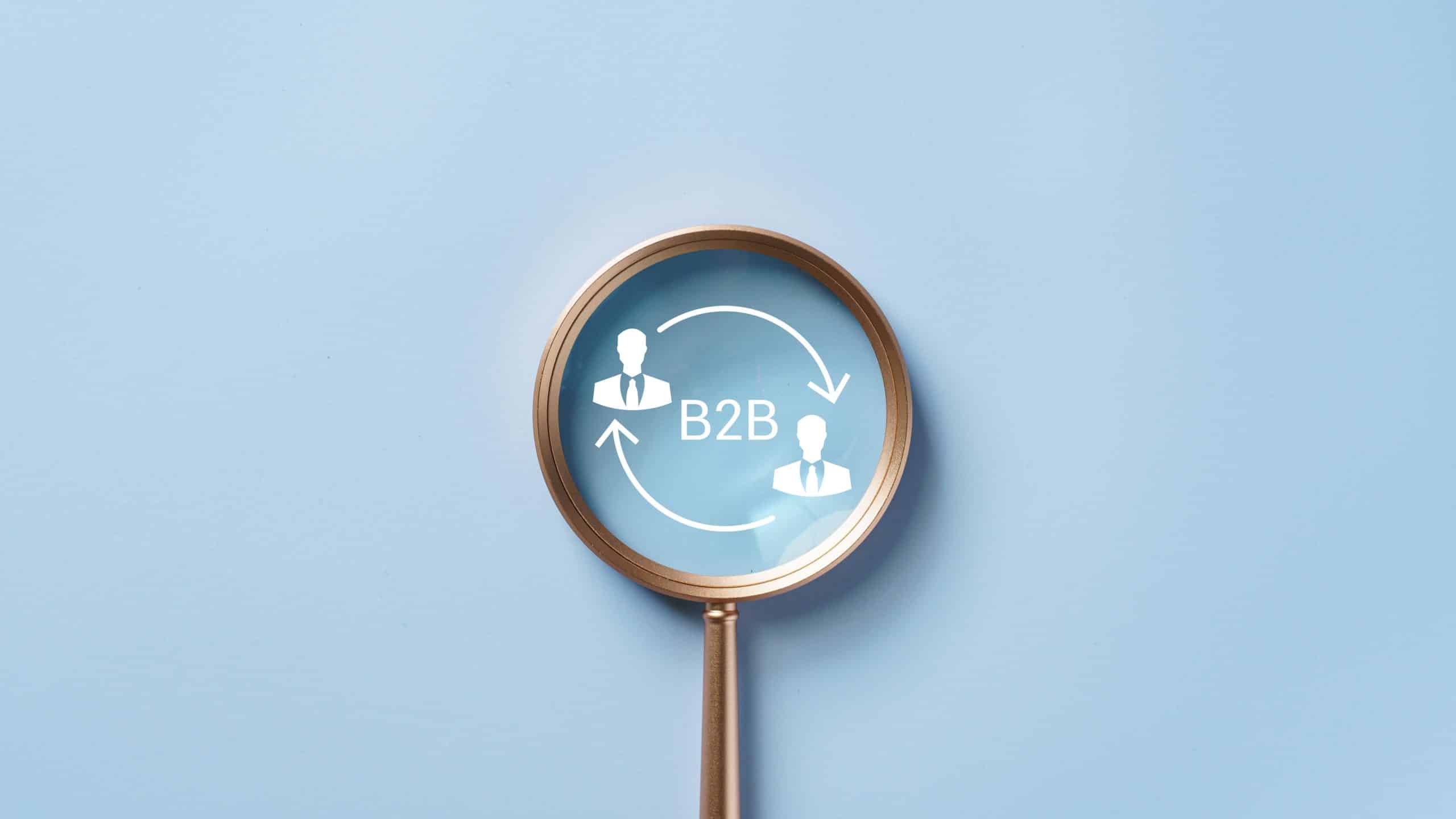- Trend 1: The Continued Rise of Account-Based Marketing (ABM) and Personalization at Scale
- Trend 2: The Power of Content Marketing and Thought Leadership in B2B
- Trend 3: Leveraging LinkedIn and Professional Networking for B2B Marketing
- Trend 4: The Increasing Importance of Video Marketing in B2B
- Trend 5: The Strategic Use of Marketing Automation and CRM Integration in B2B
- Key Takeaways
- Frequently Asked Questions (FAQs)
Some of this year’s B2B marketing trends are just emerging, while others are familiar, but all remain essential for digital marketers to master. Marketing teams are faced with tons of opportunity as they navigate a crowded field of jaded users, creating the right mix of tactics across channels to find high-intent prospects and convert them to buyers.
That customer journey is important for both the prospect and the brand: Users want personalization done well, while marketers want to get the most out of their budget while engaging these users. Marketing automation and data-driven decisions, paired with video, social media, SEO, and thoughtful content, can all help marketers succeed, even if budgets and resources stay the same.

[Source: Semrush]
Here’s a quick look, by the numbers, at where B2B marketing is and where it’s headed in 2025 and beyond:
- 48% of B2B marketers say driving enough leads is a challenge, with 24% saying there are difficulties converting leads to revenue.
- 58% of B2B marketers say lack of resources is a challenge.
- B2B customers use an average of 10 interaction channels in their buying journey now, up from five channels in 2016.
- More than 50% of B2B survey respondents want a true omnichannel experience — interacting and buying while moving seamlessly across channels.
Trend 1: The Continued Rise of Account-Based Marketing (ABM) and Personalization at Scale
Account-based marketing (ABM) and personalization at scale both meet the needs of digital advertisers and marketers today — namely, user fatigue and intense competition for attention.
ABM brings together marketing and sales teams’ efforts to create better customer experiences and drive more conversions and sales. This discipline identifies high-value accounts and tailors messaging and offers to those accounts specifically. It’s easier to measure the success of ABM campaigns, so teams can see exactly what ROI they drove. This efficiency can lead to bigger deal sizes, higher conversion rates, and shorter sales cycles. ABM tactics are suited for fragmented buyer journeys, as they can extend consistent messaging across multiple channels.

[Source: McKinsey]
With the inception of AI, ABM platforms can also now layer in deep data analysis to find patterns in customer intent. Digital marketers can get data-driven recommendations for personalizing content, tactics, and messaging to specific accounts within the ABM process. Predictive analytics tools may be embedded in other technologies, or teams may build them: Either way, B2B businesses need a single source of enterprise truth to offer better intelligence to sales and marketing teams, avoid repetition in contacting leads, and craft personalized messaging and campaigns.
Here’s what else to know about these trends:
- Up to 76% of marketers got higher ROI with ABM than any other marketing strategy.
- B2B companies using ABM report a 38% higher sales win rate and 91% larger deal sizes for 24% faster revenue growth.
- 71% of consumers expect companies to give them personalized interactions, while 76% are frustrated when that doesn’t happen.
- Faster-growing companies are driving 40% more of their revenue from personalization versus slower-growing companies.
Trend 2: The Power of Content Marketing and Thought Leadership in B2B
Seasoned web users have become quite savvy at navigating the multiple channels, offers, and companies vying for their attention, whether in B2B or B2C spaces. Alongside digital marketing tactics like ABM, personalization, and overall optimization, content marketing is essential to build an always-on program that educates and builds trust with prospects and customers.
This includes thought leadership, which can help brands stand out with a strong point of view, interesting or new data points, or deep education around a new or emerging technology or other topics. Prospects want to be engaged, and they’ll quickly navigate away from fluff or inauthentic content. Personalization also plays a role — a B2B company’s content can easily be segmented and tailored to different audiences, for example, and brands can stand out with fresh, engaging content, particularly for decision-maker and C-suite executive audiences.

[Source: Brighttail.com]
Generally, B2B brands these days have to tell interesting, SEO-informed stories to attract the attention of buyers. The range of formats and channels has expanded, and experimentation and testing can help digital marketers figure out which is best for their brand and audience, whether that’s LinkedIn articles, carousels, white papers and e-books, webinars, in-person events, case studies, or other options.
Here’s what else to know about content marketing and thought leadership for B2B this year:
- 65% of buyers said a piece of thought leadership content changed the perception of the company for the better.
- But, 30% of decision-makers rate most thought leadership as mediocre, poor, or very poor.
- 78% of content creators and marketers expect an increase in demand for their content, but less than half expect increased budget to support that demand.
- Just 43% of organizations consider their content strategy to be data-driven, though 80% say they rely on content analytics to decide what to create.
Trend 3: Leveraging LinkedIn and Professional Networking for B2B Marketing
With more than a billion users, LinkedIn has proved its staying power for B2B companies over the last 20 years. Its focus on professional networking, ad buying options, and options for company pages means it’s the primary social network for business-to-business marketing. LinkedIn has expanded its formats and channels for both paid and organic marketing efforts, so B2B digital marketers can use targeted paid ads and messages alongside organic content types (such as posts, articles, carousels, live events, groups, and polls) to engage prospects.
LinkedIn users can engage directly with their colleagues and former coworkers, as well as follow particular companies and leaders. Executives can use LinkedIn to build their own name recognition alongside their company, and brands can build their reputation there, too. The specificity and engagement levels on LinkedIn are good for lead gen: Brands see a 2x to 3x lift in their brand attributes when they advertise on LinkedIn, and marketers see a conversion rate up to 2x higher there.

[Source: Sprout Social]
Here’s what else to know about LinkedIn and professional networking trends:
- People exposed to brand messages on LinkedIn are 6x more likely to convert.
- 44% of B2B professionals ranked LinkedIn the most important social platform — number one in the survey ranking.
- Four out of five LinkedIn members drive business decisions, and the audience has twice the buying power of the average web audience.
- 89% of B2B marketers use LinkedIn for lead generation, and 62% say it produces leads.
Trend 4: The Increasing Importance of Video Marketing in B2B
Social media platforms and a proliferation of self-serve video platforms mean that video marketing is more popular than ever for B2B brands. Nearly all marketers (96%) agree that videos have helped users understand their product or service better. That number means that just about every marketer working today is incorporating video into their marketing mix, whether it’s quick mobile videos or more professionally produced short films. The trend toward short, snappy video has also reached B2B marketing, where 30-second and 15-second videos are popular.
For digital advertisers, engaging videos can help cut through creative fatigue on the right channels at the right time. LinkedIn, Facebook, and Instagram are all effective channels for B2B video, along with YouTube and TikTok as appropriate. Videos tailored to B2B audiences should show off a company’s expertise and explain or demonstrate their solutions and how they can help, educating as well as building trust and brand recognition or authority throughout the funnel, including thought leadership videos, product demos, customer quotes or testimonials, or the occasional fun video that pick up on B2B social media trends.
Here’s what else is rising to the surface when it comes to B2B video marketing:
- Short-form videos like Instagram Reels are most widely used by marketers, with 29% incorporating them in their strategies.
- 73% of consumers like to watch short-form videos to learn about a product or service.
- 89% of people say they’ve been swayed to purchase a particular product by an explainer video.
Trend 5: The Strategic Use of Marketing Automation and CRM Integration in B2B
The tried-and-true CRM platform is the foundation for many B2B companies in 2025. Taking full advantage of a CRM platform’s capabilities, alongside AI-enabled marketing automation, can save lots of time and resources, removing repetitive tasks for marketers and bringing rich data-driven insights. A digital B2B marketing team has to integrate the CRM, marketing automation tools, and other platforms like the customer data platform (CDP): That single source of enterprise truth, with data available to all teams in the business, will play a big role in success.
AI-enabled tech can help generate more qualified leads, then nurture them in a targeted way, with a buyer’s journey that tailors messaging and content and doesn’t overcontact. With prospects, as well as at a broader level, the data captured throughout the journey can inform future marketing efforts.
Consider these other numbers for using CRM, automation, and AI in 2025:
- 61% of sales leaders automated their CRM software in 2023.
- Top performers among salespeople spend about 18% more time updating their CRM system than average performers.
- 59% of marketers in 2022 were already using AI tools to optimize existing content, including for search optimization.
Key Takeaways
2025’s top B2B marketing trends aim to cut through user fatigue and oversaturated digital channels to reach the right prospects where they are. New and emerging technology, like hyper-personalization and predictive analytics, combines with foundational strategies like SEO and thought leadership to help B2B digital marketers find and convert users.
Frequently Asked Questions (FAQs)
What are the most effective digital advertising channels for B2B in 2025?
In 2025, B2B marketers have a lot of digital advertising channels to choose from. 73% of B2B marketers use social media advertising and promoted posts in their marketing strategy, while email marketing, SEO, paid search, video, open web, and influencer marketing also play a role in a digital marketing mix.
How can B2B companies measure the ROI of their digital marketing efforts?
B2B marketers can build a dashboard of relevant metrics, then continually track them and tweak the data gathered accordingly. Measuring the ROI of digital marketing efforts includes tracking lead generation rates, sales conversion rates, customer acquisition costs, and customer lifetime value, then using an ROI formula to understand the big picture.
What are some common mistakes to avoid in B2B digital marketing?
In B2B digital marketing, new trends and technology are emerging all the time. While digital marketers may make occasional missteps or overemphasize one channel or tactic over another, there are some common mistakes to avoid. These include neglecting SEO and AEO (answer engine optimization), which need regular attention and consistency for long-term success. Other common mistakes include overusing tech jargon in content, failing to include customer proof or connect with customers overall, using automation or generative AI poorly or too much, and not integrating channels and platforms, which can lead to wasted resources and duplicated efforts.
How can B2B brands build trust and credibility online?
B2B brands can build credibility by sharing useful information, educating prospects, and explaining how customers have found their product useful. This may take place through whitepapers, blog posts, webinars, events, and social media content, among others as appropriate.
What are the key metrics for measuring success in B2B digital marketing?
Key B2B digital marketing metrics are usually foundational metrics that all marketers understand. These include web data like traffic, bounce rate, engagement, conversions, and more, along with increases in leads generated, cost per lead, marketing qualified leads (MQLs), sales qualified leads (SQLs), and sales conversion rate.



